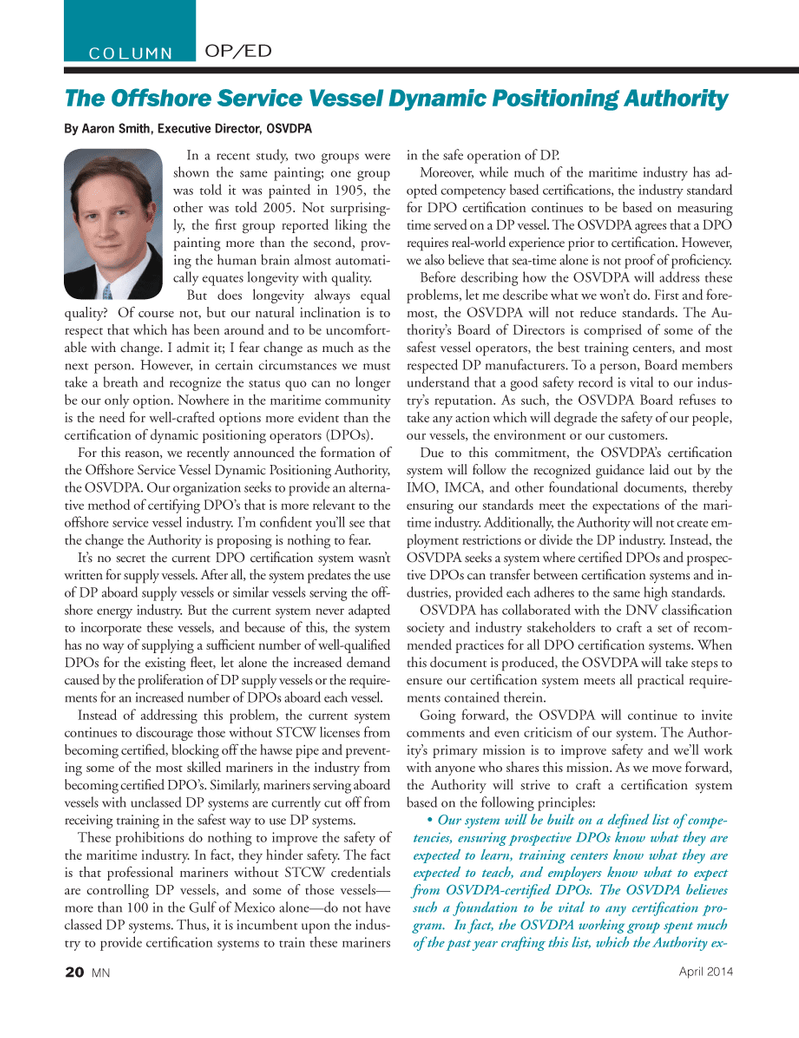
Page 20: of Marine News Magazine (April 2014)
Shipyard Report: Construction & Repair
Read this page in Pdf, Flash or Html5 edition of April 2014 Marine News Magazine
In a recent study, two groups were shown the same painting; one group was told it was painted in 1905, the other was told 2005. Not surprising- ly, the Þ rst group reported liking the painting more than the second, prov- ing the human brain almost automati-cally equates longevity with quality. But does longevity always equal quality? Of course not, but our natural inclination is to respect that which has been around and to be uncomfort- able with change. I admit it; I fear change as much as the next person. However, in certain circumstances we must take a breath and recognize the status quo can no longer be our only option. Nowhere in the maritime community is the need for well-crafted options more evident than the certiÞ cation of dynamic positioning operators (DPOs). For this reason, we recently announced the formation of the Offshore Service Vessel Dynamic Positioning Authority, the OSVDPA. Our organization seeks to provide an alterna- tive method of certifying DPOÕs that is more relevant to the offshore service vessel industry. IÕm conÞ dent youÕll see that the change the Authority is proposing is nothing to fear. ItÕs no secret the current DPO certiÞ cation system wasnÕt written for supply vessels. After all, the system predates the use of DP aboard supply vessels or similar vessels serving the off- shore energy industry. But the current system never adapted to incorporate these vessels, and because of this, the system has no way of supplying a sufÞ cient number of well-qualiÞ ed DPOs for the existing ß eet, let alone the increased demand caused by the proliferation of DP supply vessels or the require- ments for an increased number of DPOs aboard each vessel. Instead of addressing this problem, the current system continues to discourage those without STCW licenses from becoming certiÞ ed, blocking off the hawse pipe and prevent- ing some of the most skilled mariners in the industry from becoming certiÞ ed DPOÕs. Similarly, mariners serving aboard vessels with unclassed DP systems are currently cut off from receiving training in the safest way to use DP systems. These prohibitions do nothing to improve the safety of the maritime industry. In fact, they hinder safety. The fact is that professional mariners without STCW credentials are controlling DP vessels, and some of those vesselsÑ more than 100 in the Gulf of Mexico aloneÑdo not have classed DP systems. Thus, it is incumbent upon the indus- try to provide certiÞ cation systems to train these mariners in the safe operation of DP. Moreover, while much of the maritime industry has ad- opted competency based certiÞ cations, the industry standard for DPO certiÞ cation continues to be based on measuring time served on a DP vessel. The OSVDPA agrees that a DPO requires real-world experience prior to certiÞ cation. However, we also believe that sea-time alone is not proof of proÞ ciency. Before describing how the OSVDPA will address these problems, let me describe what we wonÕt do. First and fore- most, the OSVDPA will not reduce standards. The Au- thorityÕs Board of Directors is comprised of some of the safest vessel operators, the best training centers, and most respected DP manufacturers. To a person, Board members understand that a good safety record is vital to our indus- tryÕs reputation. As such, the OSVDPA Board refuses to take any action which will degrade the safety of our people, our vessels, the environment or our customers. Due to this commitment, the OSVDPAÕs certiÞ cation system will follow the recognized guidance laid out by the IMO, IMCA, and other foundational documents, thereby ensuring our standards meet the expectations of the mari- time industry. Additionally, the Authority will not create em- ployment restrictions or divide the DP industry. Instead, the OSVDPA seeks a system where certiÞ ed DPOs and prospec- tive DPOs can transfer between certiÞ cation systems and in- dustries, provided each adheres to the same high standards. OSVDPA has collaborated with the DNV classiÞ cation society and industry stakeholders to craft a set of recom- mended practices for all DPO certiÞ cation systems. When this document is produced, the OSVDPA will take steps to ensure our certiÞ cation system meets all practical require- ments contained therein. Going forward, the OSVDPA will continue to invite comments and even criticism of our system. The Author- ityÕs primary mission is to improve safety and weÕll work with anyone who shares this mission. As we move forward, the Authority will strive to craft a certiÞ cation system based on the following principles: Our system will be built on a de ned list of compe-tencies, ensuring prospective DPOs know what they are expected to learn, training centers know what they are expected to teach, and employers know what to expect from OSVDPA-certi ed DPOs. The OSVDPA believes such a foundation to be vital to any certi cation pro- gram. In fact, the OSVDPA working group spent much of the past year crafting this list, which the Authority ex- OP/EDCOLUMNThe Offshore Service Vessel Dynamic Positioning Authority By Aaron Smith, Executive Director, OSVDPA April 201420 MNMN April14 Layout 18-31.indd 20MN April14 Layout 18-31.indd 203/20/2014 11:49:15 AM3/20/2014 11:49:15 AM

 19
19

 21
21
